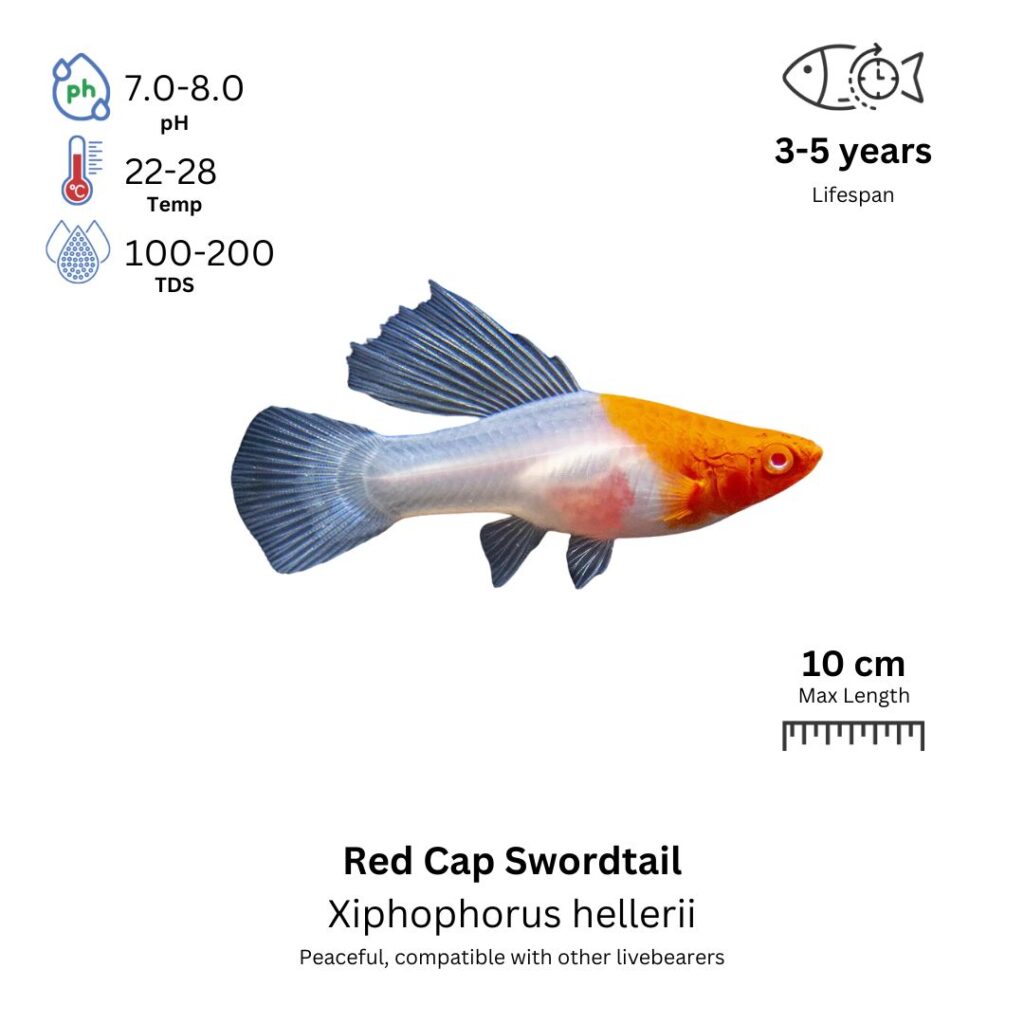Red Cap Swordtail
Xiphophorus hellerii

Description
The Red Cap Swordtail is a stunning variety of the Swordtail fish, distinguished by its unique coloration and shape. As with other Swordtails, it features a streamlined, elongated body and a characteristic “sword-like” tail fin, which is more prominent in males. The primary defining feature of the Red Cap Swordtail is the vivid, bright red coloration on its head and the top part of its body, resembling a “cap” on its head, while the rest of the body tends to be a more subdued, golden-orange or yellowish hue. The males are typically more colorful and have the elongated swordtail fin, while the females are generally larger and less colorful.
Habitat Origin
Native to Central America, particularly in rivers, streams, and lakes in southern Mexico, Honduras, and Guatemala. Swordtails, including the Red Cap variety, prefer slow-moving, warm waters with abundant vegetation and submerged structures. Their natural habitat features neutral to slightly alkaline water with a moderate flow. In the wild, they thrive in well-oxygenated environments with plenty of hiding spots and surface plants.
Aquarium
Ideal Number in Aquarium: At least 6 individuals, as they are schooling fish and feel more secure in groups.
Favorite Food

Red Cap Swordtails are omnivores and will accept a variety of foods. They can be fed high-quality flake food, micro pellets, and live or frozen foods such as brine shrimp, daphnia, bloodworms, and grindal worms. They also enjoy small plant matter, so supplementing their diet with blanched vegetables like zucchini, spinach, and lettuce is beneficial. A varied diet ensures they stay healthy and maintain their vibrant coloration.
Behavior:
Red Cap Swordtails are peaceful and social fish, often seen swimming in schools and displaying their natural schooling behavior. They are active and curious, darting around the tank in search of food and exploring their environment. While they are generally peaceful, males may become territorial, especially during breeding. Males use their long, sword-like tails to attract females and engage in courtship displays. These fish are non-aggressive and can be kept in community tanks with other small, peaceful species.
Special Care:
Red Cap Swordtails are hardy and easy to care for, but they do best in stable water conditions. Regular water changes, good filtration, and a well-maintained tank are important for their health. Since they are livebearers, managing the male-to-female ratio is essential to prevent overpopulation in the tank. Providing plenty of hiding spots for the females will also help reduce stress, especially if males are overly assertive. Swordtails benefit from a well-planted tank, which provides cover and creates a more natural environment.
Compatibility with Other Fish:
Red Cap Swordtails are compatible with many other peaceful species. They can be housed with other small, non-aggressive fish such as tetras, rasboras, guppies, and small cichlids. They are also compatible with shrimp and snails. Larger or more aggressive species should be avoided, as they may stress or harm the Swordtails. These fish are ideal for peaceful community tanks, where they can interact with other species that share similar care requirements.
Breeding Tank Setup
While not absolutely necessary, setting up a dedicated breeding tank for Red Cap Swordtails is recommended to provide a controlled environment and reduce stress from other fish. A tank size of 40–60 liters (10–15 gallons) offers enough space for the breeding pair and fry. Maintain water parameters at a pH of 7.0–8.0, temperature of 24–28°C, and 6–12 dGH for water hardness. Install a sponge filter or low-flow internal filter to keep the water clean and safe for fry. Use fine gravel or sand as substrate, and provide smooth surfaces such as stones or ceramic tubes for spawning. Live plants like Java moss and floating species will add cover and help support water quality.
Selecting Breeders
To prepare Red Cap Swordtails for breeding, offer a high-protein, varied diet. Feed them high-quality flakes or pellets along with live or frozen foods like brine shrimp, bloodworms, and daphnia. This conditioning should last about a week to ensure both male and female are in prime health. Regular 20–30% water changes and a slight temperature increase to 28°C can stimulate breeding behavior. The male will often begin courtship by displaying vibrant colors and chasing the female.
Spawning Process
Red Cap Swordtails are livebearers, meaning the eggs are fertilized internally, and the fry are born fully developed. Spawning usually occurs in the early morning or late evening under stable conditions. After mating, the female will carry the fry for approximately 3–4 weeks. A healthy female can produce 20–100 fry per cycle. Once fertilized, it’s advisable to remove the male to minimize stress and prevent repeated mating attempts, which could impact the female’s health.
Fry Care & Feeding
The fry are born able to swim and feed immediately. For the first few days, provide infusoria, liquid fry food, or finely crushed flake food. Afterward, begin introducing newly hatched brine shrimp or microworms to promote faster growth. Keep water conditions stable with 10–15% water changes every 2–3 days, and maintain the temperature at 24–28°C. Use a gentle sponge filter to maintain water quality without harming the fry, and avoid strong currents to reduce stress.
Fry Development, Sexing & Stress Prevention
Red Cap Swordtails reach sexual maturity at around 4–6 months, with females maturing slightly earlier than males. Males can be identified by their long sword-like tail extension and more vibrant colors, while females are larger, rounder, and often less colorful. To prevent stress, avoid overcrowding, ensure stable water parameters, and remove aggressive tankmates from the breeding setup. With proper care and attention, Red Cap Swordtails breed readily and can produce multiple healthy broods throughout their lives.
